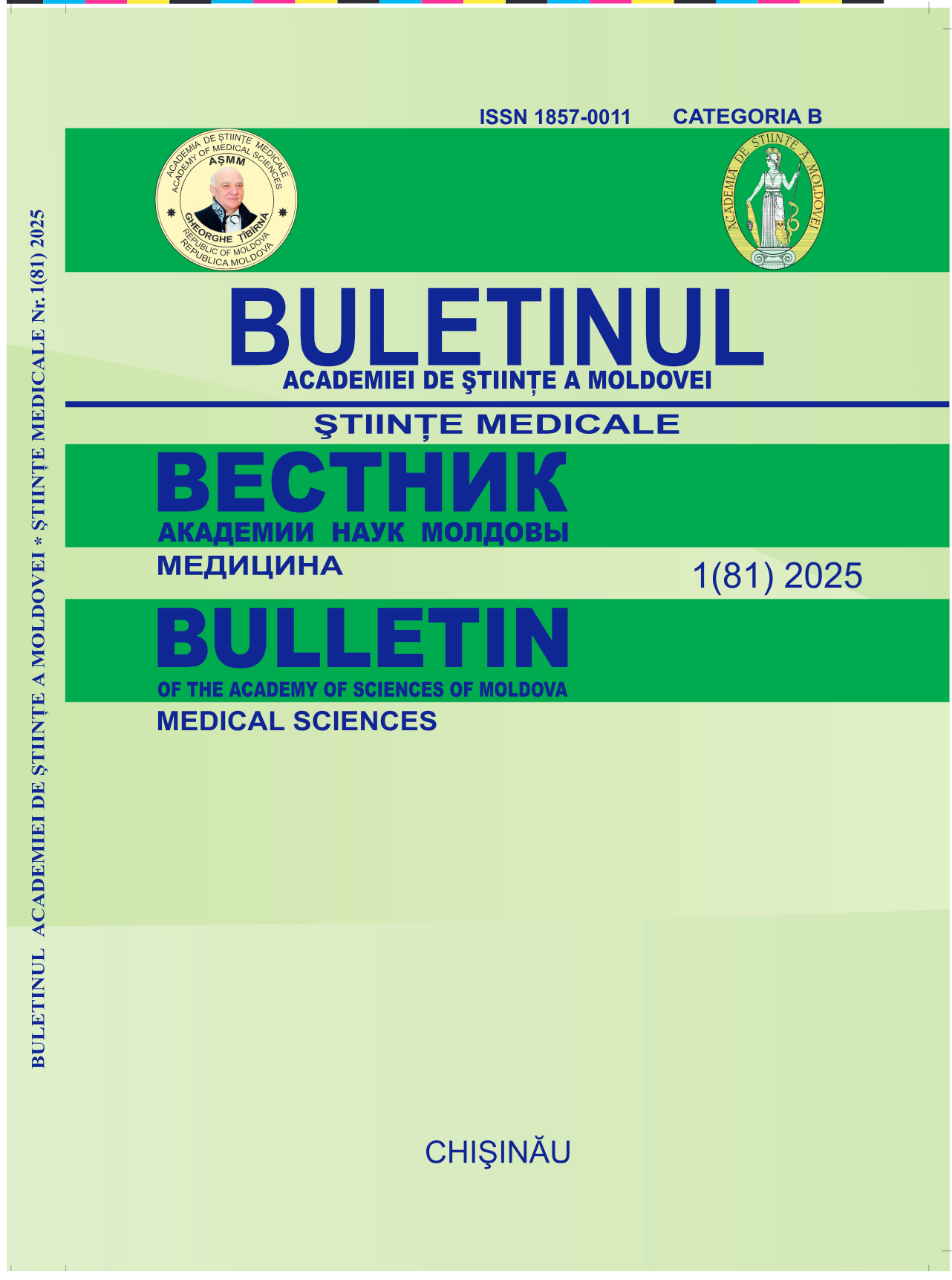Cardiac Dysfunction in Non-Hodgkin Lymphomas: The Influence of Comorbidities and Cardiovascular Risk Factors
DOI:
https://doi.org/10.52692/1857-0011.2025.1-81.06Keywords:
cardiotoxicity, chemotherapy-induced cardiac dysfunction, non-Hodgkin lymphomaAbstract
Introduction: Non-Hodgkin lymphomas (NHL) are common malignant tumors with variable progression, and current treatments can increase the risk of cardiovascular complications, including chemotherapy-induced cardiac dysfunction (CTRCD). NHL survivors have a cardiovascular death risk 5.35 times higher than the general population. Although cardiovascular risk stratification is recommended before treatment, the impact of risk factors and comorbidities in the absence of major cardiovascular diseases remains insufficiently studied. Aim of the study: To assess the cardiovascular risk factors and comorbidities associated with chemotherapy-induced cardiac dysfunction in patients with non-Hodgkin lymphoma, to identify predictors of cardiotoxicity. Materials and methods: We conducted a prospective analytical cohort study on 127 patients with non-Hodgkin lymphoma, randomly selected from the hematology departments of the Oncology Institute in Chișinău (2022-2024). The research was approved by the Ethics Committee of the “Nicolae Testemițanu” State University of Medicine and Pharmacy. Eligible patients were over 18 years old, diagnosed with NHL, and provided written informed consent. Exclusion criteria included patients with a history of other oncological diseases, pre-existing cardiovascular conditions, and advanced heart failure. The study was conducted in two stages: before and 6 months after the initiation of antitumor therapy, evaluating cardiovascular risk factors, comorbidities, and the Charlson score. Chemotherapy-induced cardiac dysfunction was defined according to the 2022 European Society of Cardiology cardio-oncology guidelines. Results: Among the cardiovascular risk factors and comorbidities associated with CTRCD development, we found that an BMI > 30 kg/m² was significantly more common in the CTRCD group (44.4%) compared to the non-CTRCD group (21.1%) (p=0.043). Patients with grade II and III hypertension had a higher prevalence in the CTRCD group (66.6%) compared to the non-CTRCD group (p<0.001). Dyslipidemia was significantly more frequent in patients with CTRCD: 94.4% in the CTRCD group vs. 61.5% in the non-CTRCD group (p=0.006). Patients with CTRCD had significantly higher median values of total cholesterol (5.9 mmol/l vs. 4.8 mmol/l, p=0.008) and LDL cholesterol (2.8 mmol/l vs. 2.2 mmol/l, p=0.013). The presence of metabolic syndrome was significantly higher in the CTRCD group: 38.9% vs. 10.1% in the non-CTRCD group (p=0.005). Stage III chronic kidney disease (K/DOQI) was present in 16.7% of patients with CTRCD, compared to 1.8% in the non-CTRCD group (p=0.027). Age, sex, abdominal circumference, triglycerides, and HDL cholesterol did not show significant statistical differences between the two groups. Conclusion: Cardiovascular risk factors such as obesity, hypertension, dyslipidemia, and metabolic syndrome were determinants of chemotherapy-induced cardiotoxicity. Renal insufficiency, regardless of severity, also increases the risk of developing cardiotoxicity. Antitumor therapy associated with CTRCD included the administration of doxorubicin, with higher doses (510 mg/m²) and an increased number of chemotherapy cycles.
References
Armitage JO, Gascoyne RD, Lunning MA, Cavalli
F. Non-Hodgkin lymphoma. The Lancet. 2017; 15;390(10091):298-310. National Cancer Institute. SEER Stat Fact Sheets: Non-Hodgkin Lymphoma - Cancer Stat Facts. 2019, https://seer.cancer.gov/statfacts/html/nhl.html.
Musteata L, Corcimaru I, Robu M, Popescu M, Durbailova G. Probleme actuale de diagnostic ale limfoamelor non-hodgkin in Republica Moldova. INFO-MED Revistă Științifico-Practică. 2016; 91–3.
Suter TM, Ewer MS. Cancer drugs and the heart: importance and management. Eur Heart J. 2013; 34(15):1102-11.
Plana JC, Galderisi M, Barac A, Ewer MS, Ky B, Scherrer-Crosbie M, et. al. Expert consensus for multimodality imaging evaluation of adult patients during and after cancer therapy: A report from the American Society of Echocardiography and the European Association of Cardiovascular Imaging. Eur Heart J Cardiovasc Imaging. 2014; 15(10).
Rihackova E, Rihacek M, Vyskocilova M, Valik D, Elbl L. Revisiting treatment-related cardiotoxicity in patients with malignant lymphoma—a review and prospects for the future. Frontiers in Cardiovascular Medicine. 2023. Vol.10. Disponibil online: https://doi.org/10.3389/fcvm.2023.1243531.
Zeppenfeld K, Tfelt-Hansen J, de Riva M, Winkel BG, Behr ER, et. al. ESC Scientific Document Group. 2022 ESC Guidelines for the management of patients with ventricular arrhythmias and the prevention of sudden cardiac death. Eur Heart J. 2022;43(40):3997-4126.
Boyne DJ, Mickle AT, Brenner DR, Friedenreich CM, Cheung WY, et. al. Long-term risk of cardiovascular mortality in lymphoma survivors: A systematic review and meta-analysis. Cancer Med. 2018;7(9):4801-4813.
Gilchrist SC, Barac A, Ades PA, Alfano CM, Franklin BA, Jones LW, et. al. Cardio-Oncology Rehabilitation to Manage Cardiovascular Outcomes in Cancer Patients and Survivors: A Scientific Statement from the American Heart Association. Circulation. 2019; 139(21):E997–1012.
Downloads
Published
License
Copyright (c) 2025 Bulletin of the Academy of Sciences of Moldova. Medical Sciences

This work is licensed under a Creative Commons Attribution 4.0 International License.



